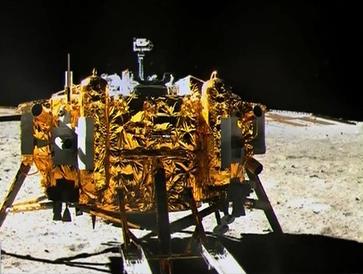Chinese Space Program 13 - Chinese Lunar Exploration Program 2
The first phase of the Chinese Lunar Explorations Program (A.K.A. the Chang'e program) consisted of two lunar orbiters, the Chang'e 1 and 2. These two orbiter were launched in 2007 and 2010. They generated highly detailed maps of the lunar surface in order to assist in the selection of a landing site for phase two.
Phase II of the Chang'e program is dedicated to lunar landers and rovers. On December 1, 2013, the Chang'e 3 was launched on a Long March 3B rocket from Xichang Launch Complex 2. It took five days to reach the moon where it orbited at about sixty miles for eight days before landing successfully on the lunar surface. The landing site was in Mare Imbrium about twenty five miles south of the Laplace F crater.
The one ton lander contained a three hundred pound rover called the Jade Rabbit. The lander has solar panels to power operations for the one year mission. It contains seven instruments and cameras. One of the cameras operates in the near-ultraviolet band around three hundred nanometers and will be used to take pictures of stars, galaxies and other astronomical phenomena. Another camera in the extreme ultraviolet around thirty nanometers will study the radiations belts around the Earth and how they are affected by solar activity.
The Jade Rabbit rover has two solar panels to provide energy. It can transmit real time video as well as perform simple tests on soil samples. The rover shuts down during the two week lunar night and uses radioisotope heaters to prevent damage from the cold. The instrument packages were activated when the rover landed but all equipment was shut down from December 16 to December 20 because of problems with the heat differential caused by one side of the rover facing the sun and the other side covered in shadow. The rover was designed to explore an area of about one square mile during a three month mission with a maximum travel distance of about six miles. The rover survived its first two week lunar night, reestablishing communication with the command center on January 11, 2014.
On January 25, 2014, it was announced that the rover had experienced a "mechanical control abnormality" due to the harsh lunar environment. Communication was reestablished in the middle of February but the rover was reported to still be suffering from a "mechanical abnormality."
The rover carries a ground penetrating radar to study the lunar surface. It can measure the depth and structure of the lunar soil to a depth of about one hundred feet. It is also capable of studying the structure of the lunar crust down to around one thousand feet. The rover also carries an X-ray spectrometer to detect alpha particles and an infrared spectrometer. These instruments are intended to analyze soils samples. The mast of the rover contains two panoramic cameras and two navigation cameras. Two additional cameras on the front of the rover are used to avoid obstacles in the cameras path.
Chang'e 3 lunar lander:
